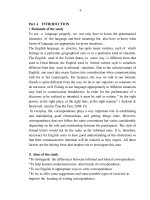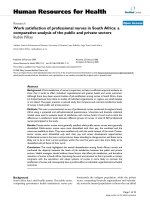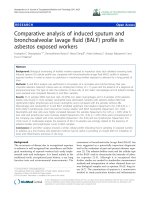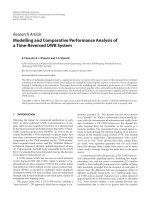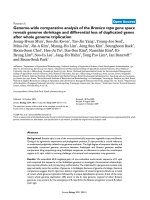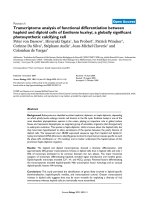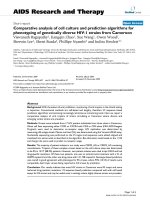Comparative transcriptome analysis of inbred lines and contrasting hybrids reveals overdominance mediate early biomass vigor in hybrid cotton
Bạn đang xem bản rút gọn của tài liệu. Xem và tải ngay bản đầy đủ của tài liệu tại đây (1.53 MB, 7 trang )
Shahzad et al. BMC Genomics
(2020) 21:140
/>
RESEARCH ARTICLE
Open Access
Comparative transcriptome analysis of
inbred lines and contrasting hybrids reveals
overdominance mediate early biomass
vigor in hybrid cotton
Kashif Shahzad, Xuexian Zhang, Liping Guo, Tingxiang Qi, Huini Tang, Meng Zhang, Bingbing Zhang, Hailin Wang,
Xiuqin Qiao, Juanjuan Feng, Jianyong Wu* and Chaozhu Xing*
Abstract
Background: Heterosis breeding is the most useful method for yield increase around the globe. Heterosis is an
intriguing process to develop superior offspring to either parent in the desired character. The biomass vigor
produced during seedling emergence stage has a direct influence on yield heterosis in plants. Unfortunately, the
genetic basis of early biomass vigor in cotton is poorly understood.
Results: Three stable performing F1 hybrids varying in yield heterosis named as high, medium and low hybrids
with their inbred parents were used in this study. Phenotypically, these hybrids established noticeable biomass
heterosis during the early stage of seedling growth in the field. Transcriptome analysis of root and leaf revealed
that hybrids showed many differentially expressed genes (DEGs) relative to their parents, while the comparison of
inbred parents showed limited number of DEGs indicating similarity in their genetic constitution. Further analysis
indicated expression patterns of most DEGs were overdominant in both tissues of hybrids. According to GO results,
functions of overdominance genes in leaf were enriched for chloroplast, membrane, and protein binding, whereas
functions of overdominance genes in root were enriched for plasma membrane, extracellular region, and responses
to stress. We found several genes of circadian rhythm pathway related to LATE ELONGATED HYPOCOTYL (LHY)
showed downregulated overdominant expressions in both tissues of hybrids. In addition to circadian rhythm,
several leaf genes related to Aux/IAA regulation, and many root genes involved in peroxidase activity also showed
overdominant expressions in hybrids. Twelve genes involved in circadian rhythm plant were selected to perform
qRT-PCR analysis to confirm the accuracy of RNA-seq results.
Conclusions: Through genome-wide comparative transcriptome analysis, we strongly predict that overdominance
at gene expression level plays a pivotal role in early biomass vigor of hybrids. The combinational contribution of
circadian rhythm and other metabolic process may control vigorous growth in hybrids. Our result provides an important
foundation for dissecting molecular mechanisms of biomass vigor in hybrid cotton.
Keywords: Heterosis, Hybrid cotton, Biomass vigor, Transcriptome, DEGs, Overdominant, Circadian rhythm
* Correspondence: ;
State Key Laboratory of Cotton Biology, Institute of Cotton Research of
Chinese Academy of Agricultural Sciences, Key Laboratory for Cotton Genetic
Improvement, Ministry of Agriculture and Rural Affairs, 38 Huanghe Dadao,
Anyang 455000, China
© The Author(s). 2020 Open Access This article is distributed under the terms of the Creative Commons Attribution 4.0
International License ( which permits unrestricted use, distribution, and
reproduction in any medium, provided you give appropriate credit to the original author(s) and the source, provide a link to
the Creative Commons license, and indicate if changes were made. The Creative Commons Public Domain Dedication waiver
( applies to the data made available in this article, unless otherwise stated.
Shahzad et al. BMC Genomics
(2020) 21:140
Background
Cotton is the prime fiber crop, comprises of more than
50 species, and evolved around 10–20 million years ago
(MYA) [1]. The upland cotton (Gossypium hirsutum L.)
has been cultivated in tropical and temperate regions of
the world, contributing 95% of natural textile fiber, and
also a substantial source of edible oil. The global population is increasing at an alarming rate, putting agriculture
sector under extreme pressure to ensure food security.
Another major constraint for sustainable crop production is hasty climate change. To mitigate these challenges, plant breeders are working hard to increase yield
and resistant against the pest, disease, biotic and abiotic
stresses in crops. In this regard, a major breakthrough
was achieved in rice, maize, sunflower, vegetables, and
fruits through heterosis breeding. Hybrid rice produced
through the utilization of heterosis gave 10–20% more
yield than conventional varieties in China [2]. Hybrids of
cotton are developed and cultivated mainly in China as
well as in India. The development of hybrid cotton at
commercial level was not started until the 1980s in
China. Since then, hybrids have been harbored with Bt
toxin gene as a result area of cultivation was increased
after the mid-2000s with the advantage of more yield
and resistance [3]. Manual crossing (emasculation and
pollination) is one of the major hurdles causing the sluggish pace of hybrid cotton seed development. However,
the cytoplasmic male sterile system has been proven an
economic tool for commercial hybrid seed production in
upland cotton in recent times [4, 5].
Heterosis breeding is not a modern day tool to increase crop yield. In the last century, people had learned
crossed fertilized plant produced more output than the
self-fertilized. However, the term heterosis was coined
by Gorge. H Shull [6]. Heterosis/hybrid vigor is a biological phenomenon to produce superior offspring’s in
characteristics of growth, biomass, stature, fertility,
disease resistance, and stress management than either
parent [7–9]. In contrast, inbreeding depression reveals
that continuous self-fertilization declined the crop yield
[10]. Allopolyploid cotton contains more than two sets
of chromosomes. In spite of this, many researchers reported cotton has significant heterosis in yield contributing and fiber quality traits [11–14]. Interspecific crosses
between upland and Pima cotton produce better fiber
traits but disease incidence was a major problem. In
contrast, intraspecific hybrids gave stability in production, improved fiber traits, and ensure seed purity [15].
In most cases, positive heterosis is required but for plant
height, maturity, and gossypol content negative heterosis
is desired in cotton.
The genetic basis of crop heterosis have been intensively researched almost for a century with different approaches. Many researchers tried to explain with the so-
Page 2 of 16
called hypothesis of dominance [16–18], overdominance
[19–21], epistasis [22, 23], and genetic distance [24, 25].
Later on, many studies in agronomic crops provide
strong evidence that the genetic basis of heterosis is perturbed. It varies with different species, stages, and traits
[26–28]. Generally, crop hybrids show heterosis at two
key stages of development e.g. vegetative and reproductive. The biomass produced in the vegetative stage controls the fate of final output, as it provides the energy
basis for architecture development and adaptation to adverse conditions. Moreover, early growth advantages increased nutrients acquisition and competitiveness in
plants. Leaf area, nodes, and vegetative branches are
established during early stage of growth in cotton, and
these eventually provide energy basis for the development of fruit branches, flower buds, and bolls. A previous study in cotton reported that during reproductive
stage any disturbance in net assimilates can disturb the
source and sink direction and finally affect the fiber
quality traits [29]. To be concise, any pitfall in vegetative
growth directly affects the final output in agronomic
crops. Many studies were performed to investigate the
molecular basis of vegetative or biomass heterosis in hybrids of rice [30, 31], maize [32, 33], wheat [34], and
Brassica [35]. But, less is conducted in cotton. Now, the
whole genome sequence of upland cotton is available
online to the researchers [36, 37]. Furthermore, highthroughput sequencing technologies have enabled researchers to investigate the molecular mechanism of
crop heterosis as a routine task [38, 39].
We designed this study to understand the genetic basis
of early biomass vigor in intraspecific hybrid cotton.
Most of past studies focused on a single hybrid and both
parents to analyze gene expression differences. However,
we sequenced root and leaf tissues of three contrasting
hybrids together with their inbred parents for better understanding the genetic aspects. Through genome-wide
comparative transcriptome analysis, we aimed to identify
DEGs, gene expression patterns, and overview the
biological pathways that mediate early biomass vigor
in cotton. Our result provides a foundation to understand the preliminary biological basis of biomass
heterosis. Furthermore, these data resources will be
important to find candidate genes of biomass vigor in
hybrid cotton in the future.
Results
Biomass heterosis exist in contrasting hybrids at the
seedling stage
Three contrasting hybrids having high (H), medium (M),
and low (L) parent heterosis in yield traits together with
their four inbred parents (denoted as A, B, C, and D)
were used to investigate the early biomass vigor in the
field. We observed high and medium hybrids did not
Shahzad et al. BMC Genomics
(2020) 21:140
show statistically significant difference in fresh biomass
(g/plant) and dry biomass (g/plant) relative to their midparent values (MPV) at 10 days after emergence of seedling (DAE) and 20 DAE (Additional file 25: Figure S1
and Additional file 26: Figure S2). However, high hybrid
showed highly significant difference in fresh biomass
compared with its MPV at 30 DAE (Fig. 1). According
to the results, low hybrid showed significant difference
in fresh biomass compared with its MPV at 10 DAE
(Additional file 25: Figure S1). Similar results were obtained at 20 DAE (Additional file 26: Figure S2) and 30
DAE (Fig. 1). High hybrid showed more biomass accumulation and low hybrid showed decreased biomass
accumulation compared to their parents. However,
medium hybrid did not show any difference in biomass
accumulation compared with both parents. These results
indicate biomass heterosis is established in hybrids as
compared to their parents during early seedling growth.
Transcriptome sequencing, mapping and global
expressions in root and leaf
Three contrasting F1 hybrids and their four inbred parents were used to perform RNA sequencing in this
study. Root and leaf tissues of the same plant with three
biological replicates were used to build 42 cDNA libraries for RNA Illumina sequencing. The brief detail of
sequencing, mapping and gene expressions of the individual library is presented in Additional file 1. The overall sequencing means of valid reads was 98.8% with a
value of 90% exon region mapping. The value of Q20%
was 99.6% in our sequencing results. In the root of A, B,
C, D, H, M, and L genotypes, mean of valid reads was
approximately 51, 54, 50, 52, 43, 46, and 45 million, respectively (Table 1). The mean of valid reads in the leaf
of A, B, C, D, H, M, and L genotypes was ~ 50, 49, 42,
Page 3 of 16
44, 45, 43, and 45 million, respectively. On an average,
more than 89% valid reads were mapped to G. hirsutum
TM-1 reference genome in this sequencing. However,
the mapped percentage in root samples was lower than
leaf. The mean of multi-mapped and splice reads was
more than 28 and 31%, respectively. In this study, the
root tissue of each genotype showed higher number of
total expressed genes compared to leaf. For example, approximately 77 thousand genes were expressed in root
of A, while it was ~ 75 thousand in leaf (Additional file
1). We also found total numbers of expressed genes in
both tissues of F1 hybrids were higher than the inbred
parents (Additional file 1).
Differentially expressed genes in root and leaf
transcriptome
Here, we analyzed the dynamic changes of root and leaf
transcriptome in all F1 hybrids and their inbred parents.
The expression levels significantly different at p ≤ 0.05
and with log2 (fold change) > 1 or log2 (fold change) < −
1 designated as differentially expressed genes in each hybrid parent triad. The total number of DEGs (Up +
down) among each hybrid parent triad is represented in
Fig. 2a. The comparative analysis in the root of hybrid
(H) compared with both parents revealed H with maternal parent (A) and paternal parent (B) respectively
showed 2917 and 2828 total number of DEGs (Fig. 2a:
Additional file 2). The comparison of both parents
ARvsBR showed 1154 total number of DEGs. In the leaf
transcriptome of H, the comparison of ALvsHL showed
3807 total number of DEGs, whereas the comparison of
BLvsHL showed a total of 2797 DEGs (Fig. 2a: Additional file 3). Furthermore, the comparison of both parents ALvsBL showed 1013 total number of DEGs.
Distribution of DEGs in H-hybrid revealed major
Fig. 1 Phenotypic heterosis observed in F1 hybrids at 30 days after emergence of seedling (DAE). a Fresh biomass observed in hybrids relative to
their mid-parent value (MPV). Here ** is used for significant difference at p < 0.01 and * at p < 0.05. b Dry biomass observed in hybrids compared
with their MPV
Shahzad et al. BMC Genomics
(2020) 21:140
Page 4 of 16
Table 1 Comparison results of leaf and root sequences on the reference genome
Samples
Valid reads
Mapped reads
Multi Mapped reads
Non-splice reads
Splice reads
AR
51128076
42941674 (84.1%)
13374298 (26%)
23022576 (45.1%)
15385894 (30.1%)
AL
50223934
48695890 (96.9%)
16157539 (32.1%)
25789688 (51.3%)
17081456 (34%)
BR
54107099
46993196 (86.8%)
14846539 (27.4%)
25014416 (46.2%)
16974977 (31.3%)
BL
49707365
48244852 (97.1%)
16086388 (32.3%)
25040718 (50.3%)
17076845 (34.3%)
CR
50767484
41842045 (82.4%)
13216507 (32%)
22208395 (43.7%)
15152915 (29.8%)
CL
42235064
40631339 (96.2%)
13500391 (32%)
21646516 (51.2%)
13975171 (33.1%)
DR
52834574
41081382 (77.7%)
12835496 (24.3%)
22221619 (42.1%)
14574574 (27.6%)
DL
44050304
42327643 (96.1%)
14086443 (32%)
22479693 (51%)
14580814 (33.1%)
HR
43141279
38301647 (88.8%)
12126751 (28.1%)
20191122 (46.8%)
13615361 (31.1%)
HL
45690950
44124014 (96.5%)
14800421 (32.4%)
23403306 (51.2%)
14810568 (32.3%)
MR
46272200
39103323 (84.8%)
12391214 (26.9%)
20472287 (44.4%)
14045575 (30.5%)
ML
43028428
39441113 (91.8%)
14204489 (32.9%)
20481512 (47.7%)
13220392 (30.8%)
LR
45335083
38959747 (85.9%)
12539366 (27.6%)
20368492 (44.9%)
13919944 (30.7%)
LL
45513687
42998982 (94.7%)
14537458 (31.9%)
22837449 (50.2%)
14431801 (31.7%)
In the table, R Root, L leaf, H high, M Medium and L Low. A, B, C, and D represents four inbred parents. Mapped reads represent the number of sequences that
were mapped to the reference genome. Multi-mapped reads aligned multiple positions on the referenced sequence. Non-splice reads were those that not
showed splicing. Spliced reads represent alternative splicing events
portion of genes was unique and less was common in
each tissue (Fig. 2b and c). For instance, 2631 genes in
roots and 2993 in leaf were unique in the combination
of H with A. Unique DEGs in comparison of B and H
was 2648 in root and 1974 in leaf. A large portion of differential gene expression is probably major determinant
of better performance in high hybrid.
The root transcriptome of medium hybrid (M) revealed comparison of M with maternal parent (A) and
paternal parent (C), respectively showed 2577 and 2144
total number of DEGs (Fig. 2a: Additional file 4). It was
observed the comparison of ALvsML had 3910 total
number of DEGs in the leaf of M hybrid, whereas the
comparison of CLvsML showed 2170 total number of
DEGs (Fig. 2a: Additional file 5). Moreover, the combination of both parents had 1067 DEGs in root and 1586
in leaf. Although results of unique and common DEGs
distribution in M hybrid identified more unique but less
common genes. However, unique DEGs were more in
the comparison of M with A than with C (Fig. 2d and e).
The comparative analysis revealed total number of DEGs
between low hybrid (L) and its maternal parent (A) was
3580 in the root (Fig. 2a: Additional file 6). The combination of L and its paternal parent (D) had 3215 total
number of DEGs. Furthermore, the comparison of
ALvsLL and DLvsLL, respectively showed 5827 and
2623 total number of DEGs (Fig. 2a: Additional file 7).
Distribution of DEGs exposed that the majority of genes
were unique, whereas less was overlap (Fig. 2f and g).
For example, A versus L had 2647 unique DEGs in root
and 4795 in leaf. Unique DEGs in DvsL were 2413 in
root and 1714 in leaf. More interestingly, both parents
of low hybrid had higher genetic differences among each
other than those of medium and high hybrids. Overall,
the result of comparative analysis of DEGs between hybrids and parents revealed that hybrids had different
genomic constituent relative to their parents. However,
comparison of both parents indicated that they have few
genetic differences among them.
F1 hybrids exhibited overdominant gene expressions
Allopolyploids have been found to exhibit expression
level dominance [35, 40]. So, to address the magnitude
and directionality of expressions in interspecific F1 upland cotton hybrids, DEGs of root and leaf transcriptome were divided into 12 possible groups as described
by Rapp et al., [41]. Genes in groups 1–2 showed additive expression. The expression of genes in groups 3–4
was termed as male expression level dominance (MELD), wherein the expression of genes in groups 5–6
was named as female expression level dominance (FELD). The expression of genes in groups 7–9 called
downregulated overdominance, wherein the expression
of genes in groups 10–12 was named as upregulated
overdominance (Fig. 3a). The result of expression patterns analysis in high hybrid (H) in both tissues detected
limited number of genes was additive expressions. Male
and female parent like expression groups also had few
genes. However, it was found overdominant upregulated
(group12) and downregulated (group 8) groups had the
highest number of genes in both tissues (Fig. 3b: Additional file 8). The analysis results of medium hybrid (M)
also dissected overdominant up and downregulated
groups had the highest number of genes in both tissues
Shahzad et al. BMC Genomics
(2020) 21:140
Page 5 of 16
Fig. 2 Total DEGs and their distribution in root and leaf of each hybrid parent triad. a shows total number of up and down regulated DEGs. Here,
R: root, L: leaf, A: maternal parent, and B, C, D represents three paternal parents of high (H), medium (M), and low (L) hybrids, respectively. b in
root c in leaf represents distribution of unique and common DEGs in high hybrid parent triad. Similarly, d in root e in leaf shows distribution of
unique and common DEGs in medium hybrid parent triad. f in root g in leaf represents unique and common DEGs distribution in low hybrid
parent triad
(Fig. 3c: Additional file 9). The analysis result of low hybrid (L) was also similar to H and M hybrids (Fig. 3d:
Additional file 10). However, groups of parent-like expression also had many genes in L hybrid as compared
to H and M hybrids. The result of expression patterns
analysis directed that overdominance at the gene expression level contributes to early biomass vigor in hybrid
cotton.
Functional annotations of overdominant genes
To understand the functions of genes with overdominant expressions in biomass heterosis, GO and KEGG
enrichment analysis was implemented in root and leaf of
hybrids. GO enrichment analysis (p-value < 0.01) of
overdominant genes in root of high hybrid (H) relative
to its parents revealed most of the upregulated genes
were involved in functions related to plasma membrane,
regulation of transcription/DNA-template, and extracellular region. Conversely, downregulated genes were
enriched in plasmodesma, integral component of plasma
membrane, and vacuole (Additional file 27: Figure S3a,
Additional file 11). KEGG pathway enrichment analysis
(p-value < 0.05) of overdominant genes showed most of
the upregulated genes were enriched in porphyrin &
chlorophyll metabolism, phenylpropanoid biosynthesis,
and oxidative phosphorylation pathways (Fig. 4a:
Shahzad et al. BMC Genomics
(2020) 21:140
Page 6 of 16
Fig. 3 The 12 possible gene expression patterns in F1 hybrids compared to their parents in root and leaf. a Expression patterns of 12 groups, M:
male parent, F1: hybrid, and F: female parent. b Total number of genes in each group in root and leaf of high (H) hybrid. c Total number of
genes in each group in root and leaf of medium (M) hybrid. d Total number of genes in each group in root and leaf of low (L) hybrid
Additional file 12). But, the majority of downregulated
genes were enriched in starch & sucrose metabolism,
phenylpropanoid biosynthesis, and circadian rhythm
plant (Fig. 4b: Additional file 12). In the leaf of H hybrid, most of the overdominant upregulated genes
were involved in functions of plasma membrane, protein serine/threonine kinase activity, and plasmodesma, while downregulated genes were involved in
cellular functions of chloroplast, membrane, and
extracellular region (Additional file 27: Figure S3a:
Additional file 13). Enriched pathways of overdominant genes found upregulated genes were enriched in
plant-pathogen interaction, plant hormone signal
transduction, and circadian rhythm plant (Fig. 4a:
Additional file 14). In contrast, significant pathways
for downregulated genes were plant hormone signal
Shahzad et al. BMC Genomics
(2020) 21:140
Page 7 of 16
Fig. 4 Enriched pathways of overdominant DEGs in root and leaf of F1 hybrids. H: High, M: Medium, and L: Low a Pathways of upregulated
overdominant DEGs. b Pathways of downregulated overdominant DEGs
transduction, carbon metabolism, and circadian
rhythm plant (Fig. 4b: Additional file 14).
The results of GO enrichment analysis of overdominant
genes in the root of medium hybrid (M) compared with its
parents uncovered that upregulated genes were enriched in
plasma membrane, extracellular region and oxidationreduction process. In contrast, downregulated genes were involved in following functions e.g. integral component of the
plasma membrane and response to salt stress (Additional file 27: Figure S3b: Additional file 15). Pathway enrichment analysis of overdominant genes found upregulated
genes were enriched in phenylpropanoid biosynthesis, amino
& nucleotide sugar metabolism, and porphyrin & chlorophyll
metabolism (Fig. 4a: Additional file 16). For downregulated
genes, enriched pathways were circadian rhythm plant, glycosaminoglycan degradation, and ascorbate and aldarate metabolism (Fig. 4b: Additional file 16). GO enrichment analysis
of overdominant genes in leaf of M hybrid revealed most of
upregulated genes performed functions related to chloroplast, chloroplast stroma, and plastid. However, downregulated genes involved in the following functions such as
chloroplast, protein binding, and ATP binding (Additional file 27: Figure S3b: Additional file 17). Pathway enrichment analysis of overdominant genes revealed most of
upregulated genes were found in carbon metabolism, phagosome, and circadian rhythm plant (Fig. 4a: Additional file 18).
